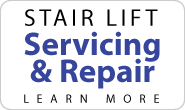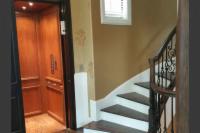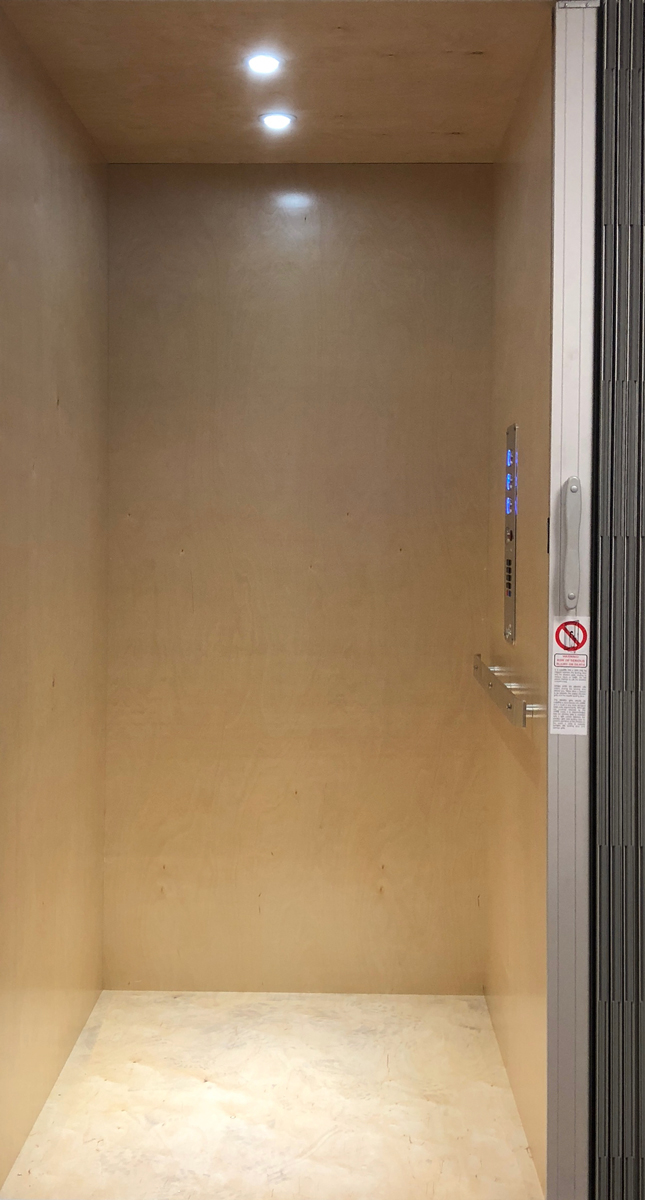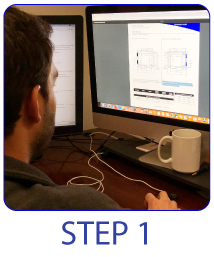
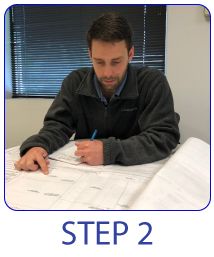
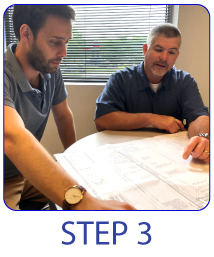
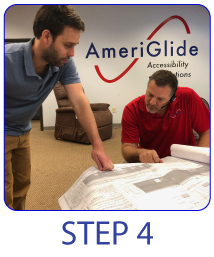
AmeriGlide is proud to offer the Elite Residential Elevator. This product is a true elevator and not a home lift. As with all real elevators, the Elite requires a hoistway or elevator shaft built to certain specifications and tolerances for it to be installed into your private residence.
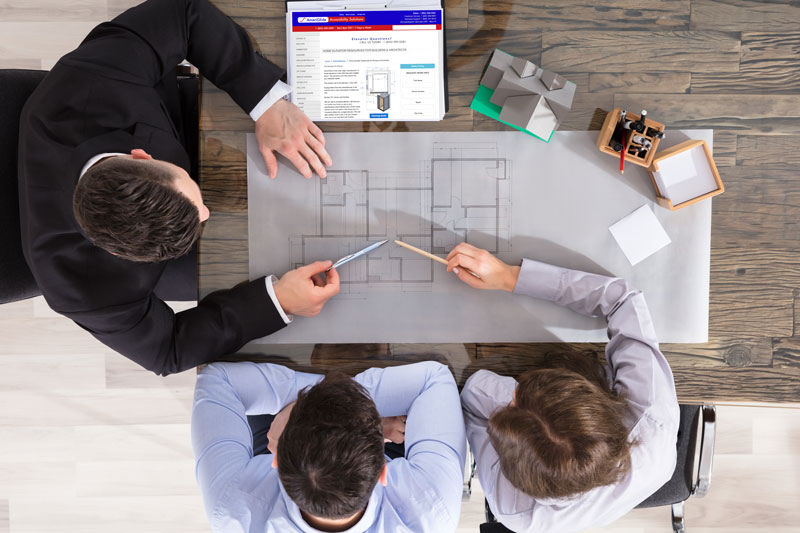 Please consult with your Architect/Contractor first.
Please consult with your Architect/Contractor first.
Before starting any residential elevator project, the home owner must be committed to finding the needed space within the existing footprint of the house and having a hoistway built; or adding a hoistway to the exterior of their home. Our smallest elevator which is 36" x 36" needs an interior finished dimension hoistway of 54" x 42". Our largest elevator, 42" x 54" requires 60" x 60". We can do many different sizes as long as the total floor space of the elevator does not exceed 15 sq. ft.
AmeriGlide strongly recommends that you hire a professional architect or design/build contracting firm to advise the best location and methods of preparing for your new home elevator. AmeriGlide does publish a full Elite Elevator Planning Guide detailing what our exact structural, electrical, pit/overhead and footprint requirements are. AmeriGlide does not offer space planning or architectural services, but we do work with your architect and contractor to make sure they understand all the technical information they must allow for in planning your new elevator.
Our Elite Residential Home Elevator is manufactured to the highest standards and complies completely with the national elevator code overseeing this equipment (ASME A17.1 Sec 5). Its use is strictly for single family private residences and cannot be used in a commercial or multifamily setting where it is available for use by more than one residence.
Once the hoistway is planned and built AmeriGlide can deliver and install your new home elevator.
We look forward to working with you on this journey.
- PLC Based Controller, ETL Listed
- Terminal and Final Limits
- Optical Landing System
- 2nd Level Homing
- Blue LED Call Buttons
- Automatic Cab Lights
- Travel Cable
- Cartop Box
- Phone
- 2 Drawing Revisions
- Travel Speed of 40 fpm (nominal)
- Standard cab size 3'x4'. Additional sizes available
- Standard cab interior height 6'8", 7'0" or 8'0"
- Electromechanical door interlocks
- Broken cable type "A" instant safeties
- Optical landing system
- "Sleep mode" to conserve energy and component life when elevator is not in use.
- Aluminum platform and rail brackets
- Load capacity of 950 lbs.
- Recessed lighting, automatic
- Stainless steel fixtures
- Concealed telephone for emergency communications
- Travel distance up to 48'5"
- Overhead clearance requirements - 6'8" cab requires 102", 8'0" cab requires 117" (measured from top landing floor level to lowest point in the elevator shaft)
- Controller supports 4 landings standard, 7 landings optional
- Automatic 2nd level homing (after 20 minutes, elevator will automatically move from the 1st level to the second level.)
- All safety features required by ASME A17.1, section 5 (National Elevator Code)
- ETL listed controller
The Elite Elevator warranty is valid for 2 years from warranty start date on all parts and components from the date of shipping per the following conditions. The motor gearbox has a 5-year warranty and commences from warranty start date. All warranties are per the terms and conditions listed below.
WD Series elevators manufactured by AmeriGlide, Inc.:
AmeriGlide, Inc. will repair or replace, at our discretion, any part or component, or any
defects in materials or workmanship, which fail or occur under normal private residence use
and indoor residential conditions during the first 2 years from the date of shipping. Damages or
failures which occur due to misuse, shipping, construction use, vandalism, and acts of god
(including but not limited to lightening, flood, fire, wind damages) are not covered by this
warranty. Damages or failures which occur during installation and/or result from improper
installation are not covered by this warranty. Labor to repair/install replacement parts is
not covered by this warranty. Shipping of replacement parts is not included in this warranty.
Construction use is defined as use of the elevator by any contractor, subcontractor or
individual before final inspection of the elevator or final acceptance from the end
user/purchaser.
Upon written notice of a warranty claim, AmeriGlide, Inc. will correct the problematic part/component within a reasonable amount of time. Parts or components in stock shall be shipped within 1 week of the warranty claim. For parts/components which are not in stock or require fabrication, a reasonable lead time will be quoted to the party submitting the warranty claim, and the part/component will be shipped once the part/component is completed.
If you have a warranty claim, promptly submit the claim, in writing, to AmeriGlide, Inc. via email, mail, or fax. Include the job name, number and description of the problem. Signed service orders/tickets from the elevator service company detailing the troubleshooting method used to determine the defective part may be required (at our discretion) for certain warranty claims. Upon receipt of the claim, we will contact the party submitting the claim and advise the status of the claim. AmeriGlide, Inc. reserves the right to request/require more detailed information and/or troubleshooting prior to processing a warranty claim.
Modifications of any type to any part or system of the elevator or lift shall void the entire warranty and completely remove any and all liability from AmeriGlide, Inc.. If a modification is deemed necessary it shall be approved, in writing, by AmeriGlide, Inc., prior to making the modification.
Residential elevator systems are very complex electro-mechanical systems which must be properly installed by a trained, licensed elevator technician. This unit requires annual service/maintenance by a licensed elevator technician. All warranties are invalid if the service record has not been completed showing annual service/maintenance.
FAQs
How much does a home elevator cost?
For most consumers, this is their first question, but there is no easy answer. Ultimately, cost depends on a variety of factors, including: how many floors will the elevator be traveling, custom finishes, cab configurations, and many more.
Your best bet is to speak with an expert who can assess your situation and provide recommendations based on your home layout, your budget, and other needs. An experienced elevator expert can usually give you a ballpark estimate in just a few minutes over the phone.
How long does it take to manufacture a home elevator?
Once the manufacturer has all the information they need to create your custom home elevator, the average manufacturing time is 6-8 weeks. This ensures that every component meets construction and safety requirements, and provides you with the right equipment to accommodate your home.
How long does it take to install a home elevator?
If the hoistway has been installed and the site has already been prepared to accommodate the new elevator, then installation can range from 1-3 days.
How much room do I need to install a home elevator?
The smallest standard cab size we offer requires a 52” x 54” hoistway, which allows for a 36” x 48” cab size. Many homes are built with the capability of adding an elevator where closets are vertically aligned.
Do I need a pit for my elevator, and how deep should it be?
Yes. A pit recessed 12” down from the bottom landing finished floor is standard. An 8” pit may be permitted in some instances.
How much overhead clearance do I need for my home elevator?
The amount of overhead clearance needed depends on the cab height. Generally, the overhead clearance will be 22” greater than the cab height. Overhead clearance is measured from the top finished floor, to the nearest obstruction in the elevator shaft.
Examples:
Cab Height: 80" - Overhead clearance: 102"
Cab Height: 84" - Overhead clearance: 106"
Cab Height: 95" - Overhead clearance: 117"
What is the best elevator drive system?
If you have been doing your research, you may have noticed that hydraulic, chain, winding drum and vacuum drive systems are used to power elevators. The overhead winding drum system is usually the preferred option for most homeowners due to the fact that it does not require a machine room. Elevators utilizing an overhead winding drum system are also referred to as Machine Room-Less Elevators, or MRL Elevators.
Do home elevators look and feel like commercial elevators?
One of the biggest differences people will notice between residential and commercial elevators are the doors, simply because everyone is used to seeing the big sliding metal doors in commercial buildings.
Our residential elevator blends seamlessly into the home with a standard left or right-hand door that can match the other doors in your home. From the outside, the only indication of an elevator will be the buttons on the wall.
The cab’s interior finishes are completely up to you ranging from a selection of melamine colors to luxurious wood choices (birch, oak, cherry, mahogany).
What are my decorative design options?
More affordable elevators will come with melamine panels. You can choose among different colors or opt for hardwood veneers, and raised panel cab designs. Options for fixture finishes, handrails, and car operating panels are available as well.
How far can a home elevator travel?
The Elite Residential Elevator can travel a maximum of 7 floors with 7 stops, which is much more than the vast majority of residential elevator installations. Most applications that require more than 7 stops will need to opt for a commercial elevator.
Are home elevators safe?
Absolutely. Residential elevators are subject to strict manufacturing and installation codes that are meant to protect consumers and offer maximum safety. As long as your elevator was properly installed, you can rest assured that it will operate smoothly and come with a long-list of safety features.
Are there financial advantages to installing an elevator?
You may be able to enjoy certain tax deductions for installing a home elevator if it is medically necessary, but be sure to check with your tax professional to see if this applies to your situation. In addition, an elevator can increase the value of your home.

